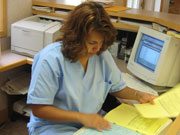   |
|
Bleach Your Teeth Crowns Dental Anesthesia Dental Implants Dentures: Get Your Smile Back Extraction of Wisdom Teeth Flossing Fluoride and Your Health Night Guards/Splints Nutrition & Dental Health Oral Cancers Porcelain Laminate Veneers Pregnancy and Oral Health Root Canal Therapy Temporomandibular Disorders TMJ/TMD The Right Time for Braces Tooth Decay: A Preventable Disease Women's Dental Health Your Child's First Dental Visit Your Child's Teeth and Gums: Tips for Parents |
Wisdom teeth, or third molars, do not always erupt properly when they decide to make an appearance. It's wise to get an early opinion from your dentist on getting wisdom teeth pulled before they become impacted, causing pain, swelling, infection, cavities or gum disease. Why don't wisdom teeth grow in right? The shape of the modern human mouth is often too small to accommodate wisdom teeth, which make their first appearance in young adults between the ages of 15 to 25. Over the course of time, humans learned to harness fire for cooking foods and developed bladed tools to better process food before consumption. They reduced the need for strong jaws to chew food. According to studies of ancient skull specimens, over time, a full set of teeth in a smaller jaw caused crowding in permanent teeth because of lack of space. What does "Impacted" mean? When wisdom teeth don't have room to grow or they haven't reached their final position by age 25, they are considered impacted: No place to go and no plans to grow. Third molar impaction is the most prevalent medical developmental disorder. A full set of healthy teeth sometimes doesn't leave much room for wisdom teeth to erupt. What kind of problems can impacted third molars cause? Partially erupted wisdom teeth are breeding grounds for bacteria and germs that may cause infection, and cysts. Tumors may grow on a trapped wisdom tooth. Jaw pain and gum disease may occur. Not all wisdom teeth cause problems, however. Can't I just use an antibiotic? Antibiotics only soothe infected wisdom teeth for a short time. Since people frequently use a wide variety of antibiotics, the infection may be resistant to such medication and doesn't solve the real problem: The tooth can't fit in your mouth. When is removal necessary? It isn't wise to wait until wisdom teeth bother you. Early removal, as advised by your dentist, is generally recommended to avoid problems, such as an impacted tooth that destroys the second molar. People younger than 16 heal easier too. At an early age, people should be evaluated by their dentist who can track third molar development with the help of X-rays. Second molars should be visible to lessen the chance of damaging them during surgery. This occurs at age 11 or 12, so wisdom teeth should be removed when the decision has been made that they cannot erupt into an acceptable position. What if I don't have any symptoms? People with symptoms of impaction, such as pain, swelling and infection should have their wisdom teeth removed immediately. However, those with no symptoms can avoid the chance of ever suffering from the pain of impacted wisdom teeth or achieve better orthodontic treatment results by having them removed. Asymptomatic impacted wisdom teeth also should be removed to reduce the chance of unexplained pain, accommodate prosthetic appliances, or avoid cavities, periodontal disease, bone shrinkage and tumor development. How is the tooth removed? Surgery for impacted wisdom teeth consists of removing of the gum tissue over the tooth, gently stripping connective tissue away from the tooth and bone, removing the tooth and sewing the gum back up. Updated July 1997 Sources: William Howard, DMD, MAGD; "The management of third molar teeth," Dentoalveolar Surgery, February 1993; "Impacted lower wisdom tooth: To remove or to leave alone," Dental Update, July/August 1994; "Surgical removal of third molars," British Medical Journal, September 1994; "Impactations. Observe or Treat?" West Virginia Dental Journal, October 1994; "Diseases and lesions associated with third molars," Oral Surgery Oral Medicine Oral Pathology, February 1995; "Early removal of wisdom teeth can prevent an array of problems," Georgia Dental Association Action, March 1994; "Patient's anxieties with third molar surgery," British Journal of Oral and Maxillofacial Surgery, October 1994; "Symptoms from impacted wisdom teeth," British Journal of Oral and Maxillofacial Surgery, December 1994; "Infections in elderly patients associated with impacted third molars," Oral Surgery Oral Medicine Oral Pathology, February 1995. This information was compiled for you by the Academy of General Dentistry. Your dentist cares about long-term dental health for you and your family and demonstrates that concern by belonging to the Academy of General Dentistry. As one of the 35,000 general dentists in the United States and Canada who are members of the Academy, your dentist participates in an ongoing program of professional development and continuing education to remain current with advances in the profession and to provide quality patient treatment. Visit the AGD's website at www.agd.org . You have permission to photocopy this page and distribute if to your patients. Posted 9-26-98 [TCJ] |
Questions - Comments - Suggestions
Should you have questions about any aspect of dental disease or treatment, or,
have a specific problem or treatment need, contact us at:
Phone: 1.707.255.3007 or E-Mail: dentist@johnsondmd.com
Address: 3434 Villa Lane, Suite #100; Napa, CA. 94558
© Copyright 2007, Thomas C. Johnson, DMD, Inc. All Rights Reserved.
